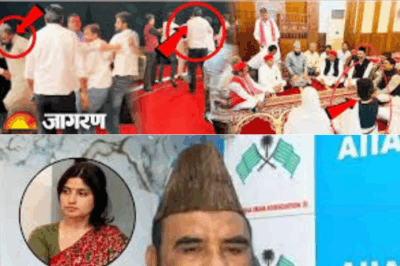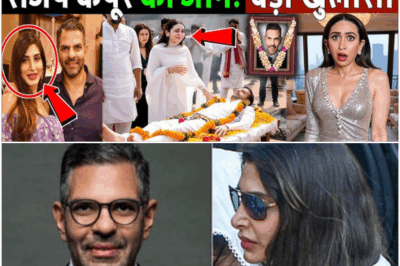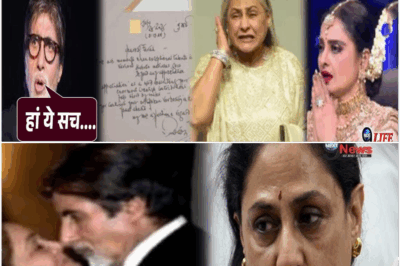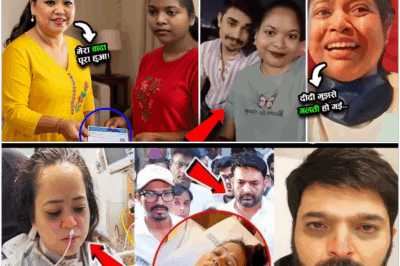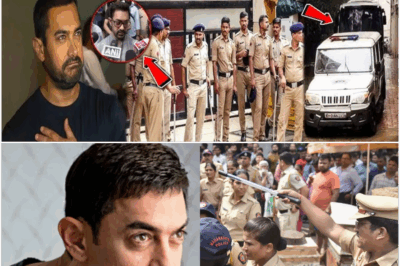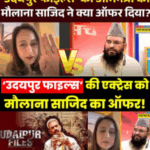Udaipur Files Row: Maulana Sajid Rashidi clashed with ‘Udaipur Files’ actress in a debate!
India, a country of vast cultural diversity and religious pluralism, has always seen cinema not just as entertainment but as a powerful mirror to society. However, in recent years, cinema has increasingly become a battleground for ideological and political confrontation. The debate surrounding a controversial film focused on mob lynching incidents—particularly targeting Muslims under the pretext of cow protection—has thrown open uncomfortable questions about freedom of expression, communal politics, and selective outrage. At the heart of this debate lies not only a cinematic story but also a larger narrative war over who gets to define the Indian identity.
In a recent televised debate, tensions ran high when a journalist posed a provocative question to an actress: Would she be willing to act in a film based on real-life incidents of mob lynching against Muslims? The anchor offered to pay her and produce the film, pushing the question in an almost confrontational manner. The actress calmly responded that she had played Muslim characters before and that if the film was based on real events, she would consider it. But the question, framed with underlying political motives, was more than just about acting. It was a rhetorical tool used to expose what the questioner believed was selective morality and cinematic hypocrisy in the Indian film industry.
The exchange quickly escalated. The anchor pressed further, citing real-life lynching incidents involving Muslims being attacked by mobs in the name of cow protection. He asked, with visible intent to provoke, whether the actress would portray such stories where “Hindus kill Muslims over cows.” She again replied with composure, reiterating her openness to perform in true stories, but the tone of the conversation indicated that it wasn’t really about a film—it was about the ideological undercurrents of what kind of stories are told and which ones are ignored.
Another panelist, visibly upset, defended the actress and rebuked the aggressive line of questioning. He argued that it was unfair to corner an artist and demand their participation in politically charged films to prove their integrity or secularism. He questioned why certain groups feel entitled to dictate what kinds of films should be made, how society should function, and how individuals must conform to their definitions of patriotism or religious harmony. He warned against the growing culture of coercion, where people are expected to behave, think, and even create art according to a narrow ideological framework.
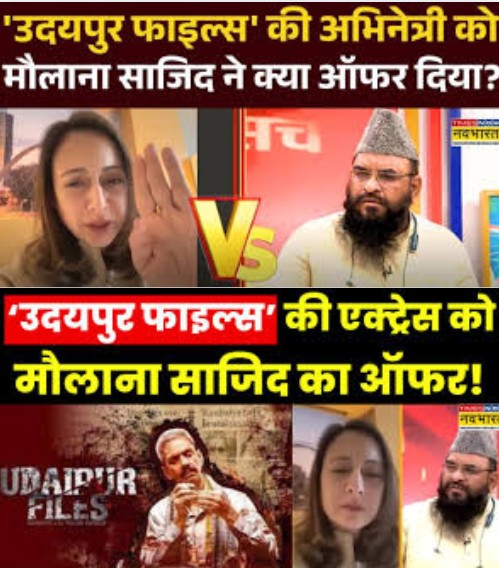
This clash on national television opened up a wider conversation about selective storytelling in Indian cinema. While some films focus on highlighting Islamic extremism or glorify nationalistic narratives, others seek to explore systemic issues such as religious discrimination, caste violence, or gender inequality. The controversy raised critical questions: Is it possible to make a film about communal violence without being labeled as anti-national? Can a filmmaker portray the lynching of a Muslim man without being accused of spreading communal disharmony? What is the role of censorship boards, courts, and the state in deciding what stories can be told?
One panelist, a well-known Muslim community leader, expressed serious concern over the film in question, which had reportedly received 156 cuts from the censor board. He noted that while the Supreme Court did not explicitly ban the release, it also did not issue a green light. The government ministries—including Information & Broadcasting, Home Affairs, and External Affairs—reviewed the film and reportedly found nothing overtly communal in its content. Yet, many felt that such films subtly reinforce anti-Muslim stereotypes and feed into existing societal polarization.
In defense, the film’s producer, Amit Jani, claimed that his work had cleared all regulatory requirements, accepted the suggestions of the censor board, and was not inflammatory in any way. He asserted that the film does not contain anti-Muslim dialogue or hate speech and that his intention was to present a balanced narrative. He added that Supreme Court had permitted the release after suggested changes, and any opposition was merely politically motivated fear-mongering.
Despite these claims, many from the minority communities remain unconvinced. Community leaders argue that even if films do not contain explicit hate speech, their underlying narratives, context, and promotion strategies often incite bias and fear. One leader remarked that if filmmakers are keen on portraying religious violence, they should also depict the lynching of Akhlaq in Dadri, or the killing of Pehlu Khan—both of whom were murdered under suspicion of cow slaughter. He emphasized that if filmmakers are interested in the truth, they must show all sides of the violence, not just those that serve a political narrative.
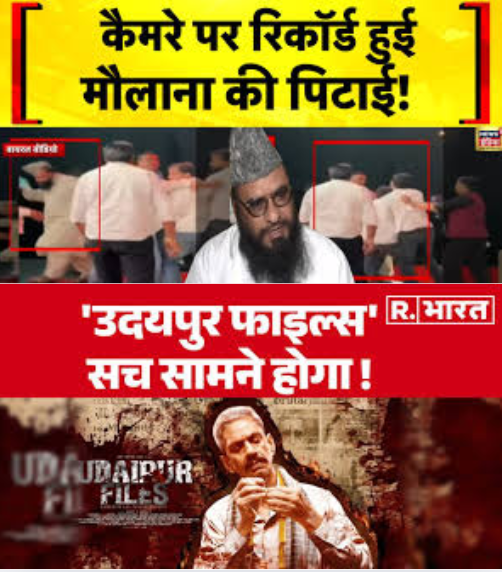
Further into the debate, the rhetoric became more heated, with one panelist accusing Muslims of feeling entitled in India and being treated “like sons-in-law of the nation.” This statement drew immediate criticism from other participants who reminded the speaker that Muslims are equal citizens of the country, not guests or outsiders. One person stated that such language was offensive, divisive, and reflective of a dangerous trend where patriotism is being defined in exclusionary terms.
The discussion also touched upon the institutional bias faced by minorities. Accusations were leveled at investigative agencies like the Enforcement Directorate (ED), Central Bureau of Investigation (CBI), and even the courts, alleging that they function with political motives. While these are serious allegations that require careful examination, their very mention underscores a growing mistrust in democratic institutions—a dangerous sign for any country.
The segment ended with a passionate plea to acknowledge all forms of violence equally. Panelists urged that just as the killing of tailor Kanhaiya Lal in Udaipur must be condemned, so must the lynchings of Muslims in the name of cow protection. They argued that selective outrage dehumanizes victims and weakens the moral fabric of the nation. True justice, they said, requires recognizing the pain of every community, not just the majority.
At its core, the debate reveals India’s current struggle: a nation caught between competing versions of its identity. On one side is an India that wants to move forward as a democratic, pluralistic society where art is free, justice is impartial, and every citizen is equal. On the other is a rising wave of majoritarianism, where religion, nationalism, and power intersect to define what is acceptable and what is not. Cinema, as always, stands at the crossroads—both a reflection of this battle and a tool for shaping its outcome.
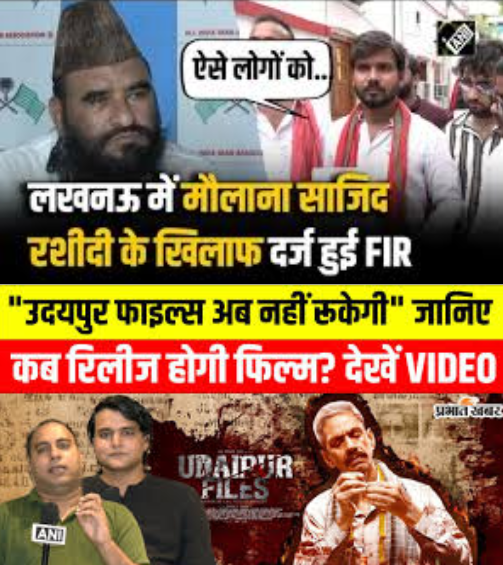
While it is valid for citizens to question the intention behind films and demand accountability, it is equally important to safeguard artistic freedom and resist the politicization of creativity. Film, after all, is not propaganda by default. It is a medium that can challenge, discomfort, heal, and inspire. If creators begin to fear backlash for telling uncomfortable truths, or if they are coerced into aligning with majoritarian ideologies, the soul of cinema—and by extension, the soul of democracy—is in peril.
This ongoing controversy is not merely about one film or one actress. It is about the kind of country India aspires to be: one where diversity is celebrated, not silenced; where dissent is respected, not demonized; and where cinema is a canvas for truth, not just a tool for narrative control.
Play video :
News
Devoleena Bhattacharjee brokedown and reacts on her 7-Month-Old Baby called Terroriist and Kala!
Devoleena Bhattacharjee brokedown and reacts on her 7-Month-Old Baby called Terroriist and Kala! In a world where social media has…
Maulana Sajid Rashidi: What happened to the Maulana who commented on Dimple Yadav? l Dimple Yadav
Maulana Sajid Rashidi: What happened to the Maulana who commented on Dimple Yadav? l Dimple Yadav A political and religious…
Wife Priya Sachdev k!||ed Sanjay Kapoor for money! Mother-in-law Rani Kapoor makes a big revelation on property dispute
Wife Priya Sachdev k!lled Sanjay Kapoor for money! Mother-in-law Rani Kapoor makes a big revelation on property dispute ….
Amitabh Bacchan’s letter reveals the secret of an unheard relationship, there is chaos in the Bachchan family.
Amitabh Bacchan’s letter reveals the secret of an unheard relationship, there is chaos in the Bachchan family. . . ….
From Unbreakable Bonds to Unthinkable Betrayal: How Bharti Singh’s Act of Forgiveness Redefined the Meaning of Family and Trust
The End of Trust: Bharti’s Final Act for Manisha . . . The End of Trust: Bharti’s Final Act for…
It became difficult for Aamir Khan to escape, police surrounded his house from all sides! 25 IAS Officers at Aamir Khan’s home
It became difficult for Aamir Khan to escape, police surrounded his house from all sides! 25 IAS Officers at Aamir…
End of content
No more pages to load


